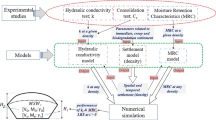Abstract
The current technologies of mineral mining, processing and beneficiation require introduction of closed water circulation. A common ecological and technological objective is in this case reduction of concentration of copper and commercial-grade fat acid ions that worsen flotation. A promising way of reaching the set objective is preliminary mixing of different waste water flows with maximum concentrations of the specified ions. The thermodynamic calculations justify optimized water treatment modes when engineering-and-economic performance of copper–molybdenum ore dressing remains unaltered, consumption of fresh natural water is lowered, and water supply is enhanced.
Similar content being viewed by others
References
Baimakhanov, M.T., Zero-Discharge Water Circulation at Non-ferrous Metal Ore-Preparation Plants with Concurrent Mastering of their Technology, Tsv. Met., 2010, no. 4.
Chanturia, V.A. and Lunin, V.D., Elektrokhimicheskie metody intensifikatsii protsessa flotatsii (Electrochemical Methods for Flotation Intensification), Moscow: Nauka, 1983.
Kozin, V.Z., Morozov, Yu.P., Koryukin, B.M., Koltunov, A.V., Tarchevskaya, I.G., and Komlev, S.G., Tailings and Tailing Dumps at Mineral Processing Factories, Izv. vuzov, Gorny Zh., 1996. nos. 3/4.
Morozov, V.V., Scientific Fundamentals of Sewage Treatment and Circulating Water Conditioning with Utilization of Valuable Components at Mining and Ore-Preparation Integrated Works, GIAB, 1999, no. 6.
Medyanik, N.L. and Girevaya, Kh.Ya., Recovery of Copper Ions from Waste Water Effluents by Precipitating-Reducing Agents, Vestn. MGTU, 2007, no. 1.
Abramov, A.A., Flotatsiya. Fiziko-khimicheskoe modelirovanie protsessov (Flotation. Physical-and- Chemical Simulation of the Processes), vol. 6, Moscow: MGGU, 2010.
Morozov, V.V. and Avdokhin, V.M., Optimization of Polymetallic Ore Processing in Terms of Monitoring and Adjustment of Ionic Composition of Pulp and Circulating Water, GIAB, 1998. no.1.
Erdenetuyaa, O., Pestryak, I.V., and Morozov, V.V., Development of Reagent-free Method for Circulating Water Conditioning at Erdenet Mining Corporation, GIAB, 2012, no. 8.
Garrels, R.M. and Christ, C.M., Solutions, Minerals, and Equilibria, New York: Jones & Bartlett Publisher, 1965.
Author information
Authors and Affiliations
Corresponding author
Additional information
Original Russian Text © I.V. Pestryak, 2015, published in Fiziko-Tekhnicheskie Problemy Razrabotki Poleznykh Iskopaemykh, 2015, No. 4, pp. 143–150.
Rights and permissions
About this article
Cite this article
Pestryak, I.V. Modeling and analysis of physicochemical processes in recirculating water conditioning. J Min Sci 51, 811–818 (2015). https://doi.org/10.1134/S1062739115040189
Received:
Published:
Issue Date:
DOI: https://doi.org/10.1134/S1062739115040189




